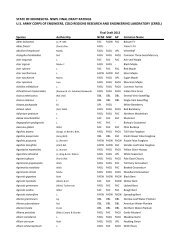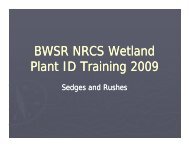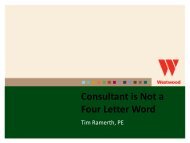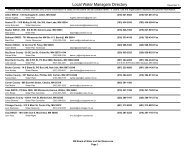BWSR Snapshots - Minnesota Board of Water and Soil Resources
BWSR Snapshots - Minnesota Board of Water and Soil Resources
BWSR Snapshots - Minnesota Board of Water and Soil Resources
You also want an ePaper? Increase the reach of your titles
YUMPU automatically turns print PDFs into web optimized ePapers that Google loves.
State <strong>and</strong> Federal Agencies Working Together<br />
on Wetl<strong>and</strong> Training<br />
By Lynda Peterson, Metro Wetl<strong>and</strong> Specialist<br />
For the past two years <strong>BWSR</strong> <strong>and</strong> the Corps <strong>of</strong><br />
Engineers (Corps) have partnered to train wetl<strong>and</strong> staff<br />
from both agencies. Wetl<strong>and</strong> staff primarily review<br />
wetl<strong>and</strong> delineations submitted by private wetl<strong>and</strong><br />
consultants, but we seldom do wetl<strong>and</strong> delineations. This<br />
partnership resulted in having Corps <strong>and</strong> <strong>BWSR</strong> wetl<strong>and</strong><br />
staff do actual on-site delineations.<br />
In 2011, two training sessions were held in Brainerd <strong>and</strong><br />
Farmington. First, delineations were completed, then<br />
wetl<strong>and</strong> staff defended why they chose a particular<br />
wetl<strong>and</strong> boundary. In 2012, two more sessions are<br />
scheduled. At a recent session in Willmar staff from<br />
both agencies reviewed aerial photographic slides <strong>of</strong><br />
agricultural fields throughout the past 20 years <strong>and</strong><br />
determined whether aerial photography showed evidence<br />
<strong>of</strong> hydrology. Then the staff from both agencies went<br />
on-site <strong>and</strong> completed wetl<strong>and</strong> delineations for the areas<br />
that showed hydrology. Ten project managers from the<br />
Corps <strong>and</strong> five <strong>BWSR</strong> wetl<strong>and</strong> specialists attended this<br />
session.<br />
At the end <strong>of</strong> May another session will be held in the<br />
Cloquet area to teach the staff from both agencies about<br />
the red clay soils that are dominant in the Northeast<br />
Region <strong>of</strong> the State.<br />
This combined training has given both agencies a<br />
comfort level with each other <strong>and</strong> involved technical<br />
abilities to provide better <strong>and</strong> more efficient program<br />
delivery <strong>and</strong> public service.<br />
Wetl<strong>and</strong> or not? That is the first Question.<br />
Second Question: where is the boundary?<br />
_ _ _ _<br />
Grass Lake Restoration – Recent Phase<br />
By Tom Wenzel, Senior <strong>Water</strong> <strong>Resources</strong> Engineer<br />
In the fall <strong>of</strong> 2011, another phase <strong>of</strong> the Grass Lake<br />
Prairie Wetl<strong>and</strong> restoration project was constructed. This<br />
phase <strong>of</strong> restoration involved a cooperative venture<br />
between the state’s Reinvest in <strong>Minnesota</strong> (RIM)<br />
Reserve program <strong>and</strong> the USDA’s Wetl<strong>and</strong>s Reserve<br />
Program (WRP), along with a private l<strong>and</strong>owner’s need<br />
to develop a suitable wetl<strong>and</strong> replacement site for recent<br />
wetl<strong>and</strong> impacts within the city <strong>of</strong> Willmar. The work<br />
was completed in the northeast corner <strong>of</strong> the Grass Lake<br />
Project area <strong>and</strong> included the restoration <strong>of</strong> several<br />
drained wetl<strong>and</strong>s with one large wetl<strong>and</strong> area<br />
approximately 80 acres in size.<br />
Historic Grass Lake <strong>and</strong> 2011 Restoration Areas<br />
The Grass Lake Prairie Wetl<strong>and</strong> is approximately 1,200<br />
acres in size <strong>and</strong> is located just to the southeast <strong>of</strong> the<br />
city <strong>of</strong> Willmar in K<strong>and</strong>iyohi County. Drainage <strong>of</strong> the<br />
lakebed began in 1885 for farming purposes. Beginning<br />
in the early 1990s, a combination <strong>of</strong> several factors<br />
including above normal precipitation cycles, increased<br />
run<strong>of</strong>f from upstream watershed areas <strong>and</strong> inadequate<br />
drainage capacity <strong>of</strong> the ditch system through the area,<br />
caused significant crop losses within the lakebed.<br />
As a result <strong>of</strong> these marginal farming conditions, most <strong>of</strong><br />
the l<strong>and</strong>owners within the basin have enrolled just over<br />
1,300 acres <strong>of</strong> the lakebed into perpetual conservation<br />
easements, primarily through RIM Reserve. These<br />
easements were secured for the purpose <strong>of</strong> restoring the<br />
drained lakebed to a shallow prairie wetl<strong>and</strong> <strong>and</strong> its<br />
surrounding shoreline to native prairie to the extent<br />
practicable.









